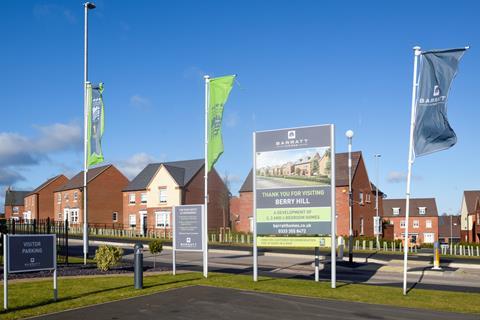Completions drop 19% and expected to fall further this year
Barratt has reported a 75% drop in its statutory pre-tax profit and a fall in completions.
Britain’s largest housebuilder reported pre-tax profit of £170.5m in its financial results for the year to 30 June, compared to £705.1m the previous year.
When adjusted for one-off costs, profit fell from £884m to £385m, while its overall turnover fell 22% from £5.3bn to £4.2bn.
Barratt’s balance sheet was hit by an extra £125.9m in charges for fire safety and external wall systems work.

It said it had identified a further 26 buildings requiring potential building safety remedial work, meaning it now has 262 buildings across 92 developments under review.
As previously reported, Barratt also identified structural issues at two developments relating to reinforced concrete frames. It said remediation work was costing an additional £56.6m, pushing up the amount set aside for reinforced concrete frames to £102.2m.
Its total provision for fire safety for the year increased to £628.1m from £535.9m the previous year.
Barratt’s total completions fell 18.6% year-on-year from 17,206 to 14,004 and it said it expects development to fall further to between 13,000 and 13,500 this year.
It said the fall reflected its “lower order book at the start of the year and ongoing slower rate of reservations throughout the financial year”. But it said the 14,004 homes number recorded was at the upper end of its expectations for the year.
David Thomas, group chief executive of Barratt, said: ”While demand continues to be sensitive to mortgage affordability, and reduced land buying activity during the past two years has had a near-term impact on the number of outlets we are operating from, we are well-positioned to meet the strong underlying demand for new homes of all tenures in the UK.”
The housebuilder’s private wholly-owned completions fell 24.2% but was partially offset by a quadrupling in private rented sector sales from 258 to 1,045 homes. Affordable housing made up 20.8% of its wholly-owned completions, down from 23.9%, which Barratt said was due to fewer registered providers buying homes through Section 106 planning agreements.
It said: “Many registered providers are facing operational and financial constraints due to the higher interest environment, as well as increased scrutiny on maintenance, repair and improvement of their existing housing portfolios.
“As a result, registered providers are less eager to secure additional affordable housing through the homes we deliver through Section 106 arrangements.”
>>See also: What does the collapse in section 106 demand mean for housing delivery?
Barratt last month completed its £2.5bn acquisition of rival Redrow, in a move which will push its turnover up to around £7bn. The two housebuilders will operate as separate entities until the Competition and Markets Authority (CMA) gives approval for the full merger.
The CMA has raised concern that the merger deal might disadvantage homebuyers in an area around Whitchurch, Shropshire, if a resulting loss of competition leads to higher house prices or lower quality homes. But it said It will publish the full text of its decision shortly.
Anthony Codling, managing director at RBC Capital Markets, said: “You can sense that Barratt just wants to get on with the integration, it is poised, pumped up and in position on its marks waiting for the starting pistol to fire.
“Barratt can see the track ahead, it can visualise the finishing line, but until it can leave its marks, it is giving its rivals a head start in a housing market is aided by political tailwinds.”
“We expect the integration to begin by the end of October, at which point it will be full speed ahead as Barratt makes up for lost time. In the meantime, outlet numbers will constrain growth.”


























No comments yet